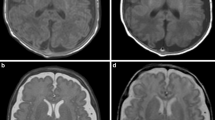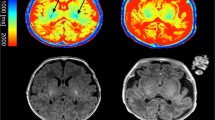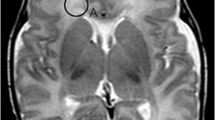Abstract
Background
T1- and T2-W MR sequences used for obtaining diagnostic information and morphometric measurements in the neonatal brain are frequently acquired using different imaging protocols. Optimizing one protocol for obtaining both kinds of information is valuable.
Objective
To determine whether high-resolution T1- and T2-W volumetric sequences optimized for preterm brain imaging could provide both diagnostic and morphometric value.
Materials and methods
Thirty preterm neonates born between 24 and 32 weeks’ gestational age were scanned during the first 2 weeks after birth. T1- and T2-W high-resolution sequences were optimized in terms of signal-to-noise ratio, contrast-to-noise ratio and scan time and compared to conventional spin-echo-based sequences.
Results
No differences were found between conventional and high-resolution T1-W sequences for diagnostic confidence, image quality and motion artifacts. A preference for conventional over high-resolution T2-W sequences for image quality was observed. High-resolution T1 images provided better delineation of thalamic myelination and the superior temporal sulcus. No differences were found for detection of myelination and sulcation using conventional and high-resolution T2-W images.
Conclusion
High-resolution T1- and T2-W volumetric sequences can be used in clinical MRI in the very preterm brain to provide both diagnostic and morphometric information.





Similar content being viewed by others
References
Holland BA, Haas DK, Norman D et al (1986) MRI of normal brain maturation. AJNR 7:201–208
Barkovich AJ, Kjos BO, Jackson DE Jr et al (1988) Normal maturation of the neonatal and infant brain: MR imaging at 1.5 T. Radiology 166:173–180
van der Knaap MS, van Wezel-Meijler G, Barth PG et al (1996) Normal gyration and sulcation in preterm and term neonates: appearance on MR images. Radiology 200:389–396
Barkovich AJ (1998) MR of the normal neonatal brain: assessment of deep structures. AJNR 19:1397–1403
Huppi PS, Inder TE (2001) Magnetic resonance techniques in the evaluation of the perinatal brain: recent advances and future directions. Semin Neonatol 6:195–210
Counsell SJ, Maalouf EF, Fletcher AM et al (2002) MR imaging assessment of myelination in the very preterm brain. AJNR 23:872–881
Counsell SJ, Rutherford MA, Cowan FM et al (2003) Magnetic resonance imaging of preterm brain injury. Arch Dis Child Fetal Neonatal Ed 88:F269–274
Barkovich AJ (2005) Pediatric neuroimaging. Lippincott, Philadelphia
Dyet LE, Kennea N, Counsell SJ et al (2006) Natural history of brain lesions in extremely preterm infants studied with serial magnetic resonance imaging from birth and neurodevelopmental assessment. Pediatrics 118:536–548
Arthur R (2006) Magnetic resonance imaging in preterm infants. Pediatr Radiol 36:593–607
Rutherford M, Srinivasan L, Dyet L et al (2006) Magnetic resonance imaging in perinatal brain injury: clinical presentation, lesions and outcome. Pediatr Radiol 36:582–592
Barkovich AJ (2006) MR imaging of the neonatal brain. Neuroimaging Clin N Am 16:117–135, viii-ix
Nowell MA, Hackney DB, Zimmerman RA et al (1987) Immature brain: spin-echo pulse sequence parameters for high-contrast MR imaging. Radiology 162:272–273
Paus T, Collins DL, Evans AC et al (2001) Maturation of white matter in the human brain: a review of magnetic resonance studies. Brain Res Bull 54:255–266
Jones RA, Palasis S, Grattan-Smith JD (2004) MRI of the neonatal brain: optimization of spin-echo parameters. AJR 182:367–372
Williams LA, DeVito TJ, Winter JD et al (2007) Optimization of 3D MP-RAGE for neonatal brain imaging at 3.0 T. Magn Reson Imaging 25:1162–1170
Conklin J, Winter JD, Thompson RT et al (2008) High-contrast 3D neonatal brain imaging with combined T1- and T2-weighted MP-RAGE. Magn Reson Med 59:1190–1196
van Wezel-Meijler G, Leijser LM, de Bruine FT et al (2009) Magnetic resonance imaging of the brain in newborn infants: practical aspects. Early Hum Dev 85:85–92
Vymazal J, Righini A, Brooks RA et al (1999) T1 and T2 in the brain of healthy subjects, patients with Parkinson disease, and patients with multiple system atrophy: relation to iron content. Radiology 211:489–495
Stanisz GJ, Odrobina EE, Pun J et al (2005) T1, T2 relaxation and magnetization transfer in tissue at 3 T. Magn Reson Med 54:507–512
Deoni SC, Williams SC, Jezzard P et al (2008) Standardized structural magnetic resonance imaging in multicentre studies using quantitative T1 and T2 imaging at 1.5 T. Neuroimage 40:662–671
Wright PJ, Mougin OE, Totman JJ et al (2008) Water proton T1 measurements in brain tissue at 7, 3, and 1.5 T using IR-EPI, IR-TSE, and MPRAGE: results and optimization. MAGMA 21:121–130
Counsell SJ, Herlihy AH, Robertson NJ et al (2000) Elevation of T1 and T2 values in the cerebral white matter in periventricular leukomalacia (abstr). The Eighth Annual Meeting of the International Society for Magnetic Resonance in Medicine. Proc Intl Soc Mag Reson Med, Denver, CO, p 1933
Counsell SJ, Kennea NL, Herlihy AH et al (2003) T2 relaxation values in the developing preterm brain. AJNR 24:1654–1660
Lewis HJ, Allsop JM, Counsell SJ et al (2001) MR quantification of the brain in preterm infants at term equivalent age (abstr). The Ninth Annual Meeting of the International Society for Magnetic Resonance in Medicine. Proc Intl Soc Mag Reson Med, Glasgow, UK p 405
Ferrie JC, Barantin L, Saliba E et al (1999) MR assessment of the brain maturation during the perinatal period: quantitative T2 MR study in premature newborns. Magn Reson Imaging 17:1275–1288
Thornton JS, Amess PN, Penrice J et al (1999) Cerebral tissue water spin-spin relaxation times in human neonates at 2.4 tesla: methodology and the effects of maturation. Magn Reson Imaging 17:1289–1295
Williams LA, Gelman N, Picot PA et al (2005) Neonatal brain: regional variability of in vivo MR imaging relaxation rates at 3.0 T—initial experience. Radiology 235:595–603
Herlihy AH, Counsell SJ, Rutherford MA et al (1999) T1 and T2 measurements of the preterm brain (abstr). The Seventh Annual Meeting of the International Society for Magnetic Resonance in Medicine. Proc Intl Soc Mag Reson Med, Philadelphia, PA, p 531
Huppi PS, Warfield S, Kikinis R et al (1998) Quantitative magnetic resonance imaging of brain development in premature and mature newborns. Ann Neurol 43:224–235
Prastawa M, Gilmore JH, Lin W et al (2005) Automatic segmentation of MR images of the developing newborn brain. Med Image Anal 9:457–466
Xue H, Srinivasan L, Jiang S et al (2007) Automatic segmentation and reconstruction of the cortex from neonatal MRI. Neuroimage 38:461–477
Anbeek P, Vincken KL, Groenendaal F et al (2008) Probabilistic brain tissue segmentation in neonatal magnetic resonance imaging. Pediatr Res 63:158–163
Dubois J, Benders M, Cachia A et al (2008) Mapping the early cortical folding process in the preterm newborn brain. Cereb Cortex 18:1444–1454
Nguyen The Tich S, Anderson PJ, Shimony JS et al (2009) A novel quantitative simple brain metric using MR imaging for preterm infants. AJNR 30:125–131
Weisenfeld NI, Warfield SK (2009) Automatic segmentation of newborn brain MRI. NeuroImage 47:564–572
Merisaari H, Parkkola R, Alhoniemi E et al (2009) Gaussian mixture model-based segmentation of MR images taken from premature infant brains. J Neurosci Methods 182:110–122
Gudbjartsson H, Patz S (1995) The Rician distribution of noisy MRI data. Magn Reson Med 34:910–914
Cheng HL, Wright GA (2006) Rapid high-resolution T(1) mapping by variable flip angles: accurate and precise measurements in the presence of radiofrequency field inhomogeneity. Magn Reson Med 55:566–574
Pipe JG (1999) Motion correction with PROPELLER MRI: application to head motion and free-breathing cardiac imaging. Magn Reson Med 42:963–969
Haacke EM, Brown RW, Thompson MR et al (1999) Magnetic resonance imaging: physical principles and sequence design. Wiley, Toronto
Acknowledgments
This research was supported by the Canadian Institute of Health Research (CIHR MOP-84399). We would like to thank the time and effort spent by our neuroradiologist raters, Drs. M.M. Shroff, C. Raybaud, J.P. Soares-Fernandes and B. Thomas. We thank MRI technologists Garry Detzler and Ruth Weiss and NICU nurses Angela Thompson and Deborah Singleton, who helped with patient recruitment and were responsible for the well-being of the neonates during scanning.
Author information
Authors and Affiliations
Corresponding author
Rights and permissions
About this article
Cite this article
Nossin-Manor, R., Chung, A.D., Morris, D. et al. Optimized T1- and T2-weighted volumetric brain imaging as a diagnostic tool in very preterm neonates. Pediatr Radiol 41, 702–710 (2011). https://doi.org/10.1007/s00247-010-1955-5
Received:
Revised:
Accepted:
Published:
Issue Date:
DOI: https://doi.org/10.1007/s00247-010-1955-5




